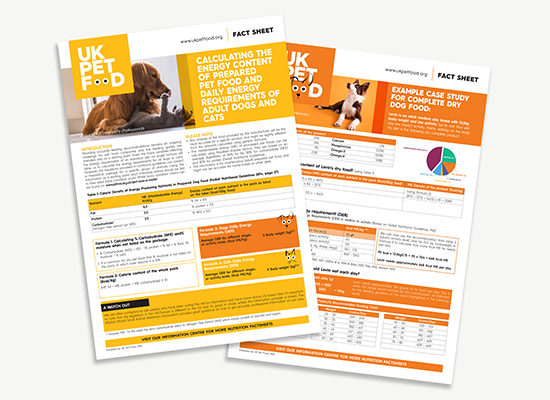Calorie calculating formulas for vets
The energy requirements of dogs and cats vary considerably, even between animals kept under the same conditions. This wide variation between individual animals can be the consequence of differences in age, breed, body condition, etc. It can also be caused by environmental factors such as temperature.
It's therefore important to remember when using food calculators, remember that no single formula can calculate the energy requirements for all dogs or cats. Every equation only predicts a theoretical average for a specific group of animals.
Key things to note when calculating an animal's energy requirements:
Factoring in activity levels
The range of equations for different activity levels given in this fact sheet are based on Fediaf Nutritional Guidelines.
However, many owners are likely to over-estimate their dog’s exercise levels. This would lead into selecting an equation that is too high for their pet and therefore overfeeding them. In light of that, for the majority of pet dogs that only walk on the lead or are likely to be active for up to one hour per day, it is recommended to use the lowest equation (95) from Table 2 of the fact sheet.
Regular weighing of the pet and adjusting to their need based on weight gain/loss is recommended.
The contribution of carbohydrates & fibre
Carbohydrate is a general term in biochemistry and mainly includes sugars, starch and dietary fibre.
Sugars and starches are sources of energy for cats and dogs as they have the specific enzymes to break them down into smaller molecules, which can then be absorbed by the body.
Like the human, cats and dogs lack enzymes to break down dietary fibre. Dietary fibre is the indigestible part of food that comes from plant based ingredients. It has proven to have health benefits for dogs and cats and has two main components:
- Soluble fibre, which dissolves in water and is fermented in the colon
- Insoluble fibre, which does not dissolve in water, is metabolically inert and provides bulking, but may also contain some prebiotic fibre which ferments in the large intestine. Bulking fibres are useful because they absorb water as they move through the digestive system, easing defecation.
Calculating for light diets
Most light diets have high levels of dietary fibre, compared to normal maintenance diets. Insoluble fibre promotes satiety but contributes no calories to the diet of cats and dogs.
Soluble fibre is partially fermented, with the degree of fermentability varying with the type of fibre, and contributes some energy when broken down and absorbed by the body. This means the equations needed to calculate the energy content of light diets will be different from the equations used in this fact sheet. To avoid overestimating the energy value of a light pet food product, which could lead to underfeeding, please contact the manufacturer of the product for further details.
Other important things to note
- Any analysis of the food provided by the manufacturer will be the most accurate for a specific product and might be slightly different from the amounts calculated using generic formulas.
- The metabolisable energy (ME) of processed pet foods can be calculated using Modified Atwater factors. They are based on an average digestibility of 90% for fat, 85% for carbohydrate (NFE) and 80% for protein (Fediaf Nutritional Guidelines).
- This information is for maintenance (adult) prepared pet food, and might not be accurate for home-made or other diets.
- Puppies and kittens have a much higher energy requirement compared to adult dogs and cats and therefore the recommendations in this sheet are not appropriate for them. Puppies and kittens must be fed on a suitable growth product that meet their specific nutritional requirements.
- In this sheet the term ‘calorie’ refers to kilocalorie unit of energy (symbol: kcal).
- The term carbohydrate, in this sheet, refers to Nitrogen Free Extract (NFE) which mainly consists of starches and sugars.
- Some brands of pet food have lower feeding amounts due to the formulation of their diets and different levels of digestibility. Always contact the manufacturer for the most accurate calorie content of their product and feeding guides.
Using the formulas
To calculate the daily energy requirements (DER), use Formula 3 for dogs and Formula 4 for cats, as explained in our Calorie Counting fact sheet.
- Formula 3 = Average DER for an adult Dog with a specific activity level x body weight (kg) to the power of 0.75.
- Formula 4 = Average DER for an adult Cat with a specific activity level x body weight (kg) to the power of 0.67.
Any scientific calculator has the ‘power’ button which is normally shown with one of these signs [X^y] or For example to work 10 to the power of 0.67 using a calculator;
- Enter 10
- Press the [Xy] or [x^y] button.
- Enter 0.67
- Press =
You should get the answer 4.67.
You can also use the internet by typing ‘10 to the power of 0.67’ in your internet browser and you should see the same result.

